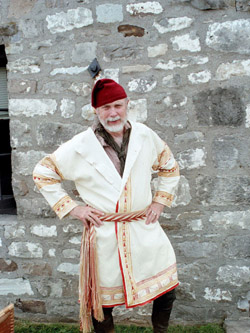
|
|
"Eastern Frontier Artwork"
Robert Griffing's presentation will deal with the 18th Century Eastern Woodland Indian's appearance such as dress, body tattoos, adornments, and jewelry.
Robert Griffing
Robert Griffing grew up in Linesville,
Pennsylvania. In his youth he roamed the fields and beaches around Pymatuning
Lake collecting stone artifacts, the key factor for his love of history
and native cultures. At an early age, he gained an appreciation for the
area's history; it’s natural beauty and the region’s first inhabitants,
the Eastern Woodland Indians, which especially fascinated him.
After graduating form the Art Institute of Pittsburgh, Robert Griffing
enjoyed a highly successful thirty-year career in commercial art. Among
his accomplishments is the design of the well-known cowboy hat logo for
the Arby's fast food restaurant chain. When he finally retired from the
commercial art world, "Griff," as he is known to his friends,
devoted his efforts to painting his longtime loves, Woodland Indians,
nature and history. He quickly became recognized as one of the foremost
historical artists working today and is certainly the premier painter
specializing in 18th century Woodland Indians.
In 1993, “U.S. ART” magazine listed Robert Griffing as an artist to watch for in 1994. In
1994, that same magazine listed him as one of the top 25 selling artists
of that year. The November 1995 issue of “U.S. ART” featured
an article on Eastern Woodland Indians and chose Griffing's "Logan's
Revenge" for the cover. His artwork has also graced the covers of
many issues of “Muzzleloader” magazine. Both Griffing's original
art and his limited edition prints are in great demand.
Like many of the people in his paintings, Robert Griffing is a pioneer. It was not all that long
ago that both artists and their publishers were reluctant to risk producing
Eastern historical artwork. The real market and therefore the profit was
in Western art. Not only were Griffing and his publisher, Paramount Press,
the first team to risk doing Woodland Indian art on a large scale, but
also they have been innovative in other ways. Along with the print “The
Taking of Mary Jemison,” they produced an excellent videotape that
tells the history of the actual event and also chronicles the progress
of the painting.
When it comes to historical accuracy, Griffing treats both sides of the conflict with the same care
and precision. The clothing, uniforms, weapons and accoutrements illustrated
are all correct and authentic to the period. So too are the natural backgrounds,
such as the forests, the rivers and streams, and the dwellings and fortifications.
The details of both the Indian and white 18th century cultures are researched
in minute detail. The resulting accuracy of the paintings comes from Griffing's
love of history, knowledge of the woods and his natural talent to put
what he sees down on canvas.
Another element enhancing his
artwork is his participation in "living history," where he is
able to actually experience, as closely as possible, how our ancestors
lived. It is one thing to read about an historic trek or canoe trip, but
it is much better to experience it yourself, covering the same ground,
wearing period clothing and using only authentic gear and weapons. Of
re-enactors Griffing says, "Some of my closest friends today are
relatively recent acquaintances I have made at re-enactments. To tap into
the knowledge they have . . . is very important to me.” In addition
to his extensive library of books, historical papers and journals, he
is grateful to his historian and re-enactor friends who provide information
and act as models for some of the characters in the paintings.
He describes himself as a painter
of 18th century scenes that involve or feature the Eastern Woodland Indian.
His Paintings focus on a time that marked the beginning years of chaos
and uncertainty for the Woodland tribes as they struggled to survive the
encroachment of Europeans.
Griffing hopes that his paintings shed some light on this time period
that has been neglected through society's romance with the American West.
|
500x331x16M png
|
1556x1153x16M jpeg
|
|
500x331x16M png
|
1536x1024x16M jpeg
|
Examples
of Robert Griffing's Work
(Click
image for larger view)
Robert's Web Page <<click here>>
 |
 |
 |
| Caught
Midstream |
Conspiracy At Fort Michilimackinac, | Friend or Foe |
| 580x446x16M jpeg | 769x535x16M jpeg | 343x460x16M jpeg |
 |
 |
|
| Post & King Beaver at Ft. Duquesne | Leaving | New Day, New Rifle |
| 1024x1536x16M jpeg | 385x465x16M jpeg | 859x571x16M jpeg |
 |
 |
|
| Only a Matter of Time | Tecumseh | The Bark Cuters |
| 485x569x16M jpeg | 668x426x16M jpeg | 1296x864x16M jpeg |
 |
||
| The Portage | The Taking of Mary Jamison | The Voyage of Discovery Begins |
| 619x370x16M jpeg | 615x339x16M jpeg | 867x576x16M jpeg |
| The Winter Trade | We Dined in a Hollow Cottonwood Tree | A Charming Field For An Encounter |
| 800x499x16M jpeg | 1000x653x16M jpeg | 792x248x16M jpeg |
|
FUTURE SHOW DATES
|
||||
|
March 20-21,
2010
|
• |
March 19-20,
2011
|
• |
March 17-18,
2012
|
Copyright © 2007 Yankee Doodle Muzzle Loaders, Inc. All rights reserved.
This website may not be reproduced, in part or in whole, without the written permission
of Yankee Doodle Muzzle Loaders, Inc.
This web page is designed to be viewed best at 800 x 600 true color.
|

|
||
|
|
Weather
|
|
|




